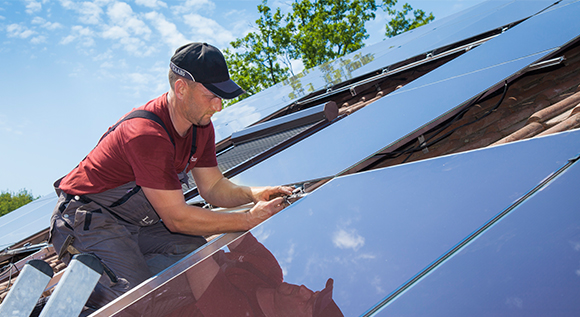Photovoltaic installations: a high-quality product with a low risk of fire
A research report on photovoltaic installations funded by the Federal Ministry for Economic Affairs and Energy has found that the fire risk is low and can be reduced even further by taking a few simple precautions. The report sets out practical tips on how to plan, install, and operate photovoltaic installations safely in order to keep the chances of fire to a minimum.
 © BMWi/ Maria Parussel
© BMWi/ Maria Parussel
When it comes to our streetscape, solar panels on house rooves are a familiar sight. The fact that they can be used to produce climate-friendly electricity is well-known. Aside from the benefits, however, do photovoltaic installations actually pose a fire risk? A number of headlines have led many people to question their safety. A research project funded by the Federal Ministry for Economic Affairs and Energy has therefore explored two specific questions: Can photovoltaic installations cause a fire? And are fire-fighters dealing with such fires actually exposed to an elevated level of risk? In order to conduct their investigations, the research partners – Technischer Überwachungsverein Rheinland (private conformity assessment body) and the Fraunhofer Institute – enlisted the support of various professional associations, industrial partners, local fire services, installation companies, insurance providers, and operators of installations.
High-quality materials, professional installation, regular system checks
The study starts by looking at all of the fires known to have involved photovoltaic installations and concludes that the largest number of these was based on faulty installation, followed by product and planning faults. This means that in the majority of cases, human error was to blame. If an electrical current flows through a contact that is damaged or has been incorrectly installed, an electric arc can occur. This is seen as very bright light, produces crackling noises, and can go on to reach very high temperatures. However, serious incidents such as these can be prevented through the use of high-quality materials, through professional installation, and through regular system checks.
As part of the research project, a set of guidelines was developed to provide installation technicians and operators of systems with recommendations on how they can keep fire risks for systems old and new to a minimum. These contain information on how to plan, install, and operate photovoltaic installations safely in order to keep the chances of fire to a minimum.
Information warning for the fire services raises safety
Research was also conducted into the safety of the fire services when dealing with fires involving photovoltaic installations. The study concluded that affixing a simple information warning for the fire services ensured that fire-fighters held the necessary minimum distance from the fire, and was the most important safety measure to be taken. Simulation tests have confirmed that by holding a distance of five metres when releasing water at full pressure and of one metre when using water spray, fire-fighters are not exposed to any extra risk.
The Federal Ministry for Economic Affairs and Energy provided funding of around 1.7 million euros for the research project, entitled "Assessment of fire risks and development of safety concepts to reduce risk". Given the plans to increasingly combine photovoltaic installations with electricity storage facilities in the future, the Federal Ministry for Economic Affairs and Energy is currently providing 3.8 million euros of funding for a follow-on project. The project, which is being coordinated by Technischer Überwachungsverein Rheinland, is examining the specific risks of damage by electrical storage and is entitled "Safety and reliability of photovoltaic installations with storage systems with a particular focus on fire risks and extinguishing strategies" [German project abbreviation: SPEISI]).

